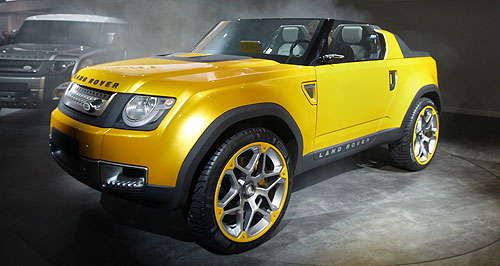Future models - Land Rover - Defender - SportFrankfurt show: Land Rover's surprise DC100 SportStand and Defender: The Land Rover DC100 concept is sure to polarise opinions, especially with the open-top Sport variant. Striking sports ute variant spices up Land Rover’s Defender replacement concept14 Sep 2011 IN ADDITION to publicly unveiling its DC100 concept that “investigates the potential future design direction of the iconic Defender” ahead of a planned 2015 release, Land Rover sprung a surprise on the Frankfurt crowds with a brightly-coloured, open-roof DC100 Sport variant. The striking DC100 Sport, a two-seat sports ute described by Land Rover as “an active expression of freedom and leisure” that “represents a more assertive, performance-oriented interpretation of the classic Land Rover look”, serves to suggest the next Defender will be just as flexible as its predecessor in terms of varying body styles. While taking cues from the canvas-roof Defenders of old, the Sport – which at 4135mm long is 337mm shorter than its wagon counterpart but rides on an identical 100-inch (2540mm) wheelbase – has thoroughly modern metallic amber paintwork said to echo the “vibrant ochre hues” found in Africa. Under its twin-hump, fastback rear deck is a “generous” load area featuring fittings for securing extreme sports equipment such as kite-surf boards. Not just a styling exercise, the DC100 twins also showcase Land Rover’s thinking in terms of how to raise the bar over the existing Defender’s legendary levels of practicality and adaptability through the application of modern technology – at the potential risk to its predecessor’s endearing simplicity. However, Land Rover Australia spokesman James Scrimshaw told GoAuto the DC100 simply acts as a showcase of the brand’s technology. He said the concept’s features would not necessarily be standard on the next Defender but could well be employed across the wider Land Rover stable.  “There are some really good technologies there that could easily be comfortable in Range Rovers and other things,” he said. Mr Scrimshaw said the next Defender’s target entry price is below £20,000 ($A30,706) in the UK market – which undercuts the existing base model’s price by at least £1000 – and that the company hopes to achieve this through increased global volume while trying not to put off the Defender die-hards and traditionalists. “We are trying to find that middle ground where we can keep our loyal customers happy and hopefully move them to change a bit, but we do need to get a lot of new customers and want to get the numbers back up to 50,000-plus a year as at the moment we’re slightly under 20,000 units a year with Defender,” he said. The new Defender is designed to attract new customers to the brand as well as return Land Rover to markets from which the existing Defender – which has been around for six decades – has been forced to withdraw on safety and emissions grounds. “It’s a huge opportunity for volume,” said Mr Scrimshaw. “We definitely want the US market to be more of a buyer and also the emerging markets as well. “We’ve got to make sure we’ve got a decent entry-level point.” In addition to a winch and highly visible towing points, the DC100 introduces three new technologies that reinforce and enhance its off-road credentials – Intelligent Terrain Mapping, Wade Aid and On-Demand Spiked Tyres. The ‘Terrain-i mapper’ uses a scanner mounted in the headlights to build a three-dimensional assessment of the route ahead, which it displays on the central touch-screen and warns the driver of obstacles too large to be safely negotiated while suggesting alternatives. It also doubles as an urban safety aid, functioning like Volvo’s City Safety pedestrian detection system while providing feedback to the DC100’s next-generation Terrain Response computer to maximise traction. As the name suggests, Wade Aid helps the driver make a decision on whether to attempt crossing a flooded area, using a sonar-based system that combines inputs from sensors in the bumpers and door mirrors with inclinometers that recognise whether the water level is increasing or decreasing. The system automatically raises the ride height, closes body vents and selects the optimum gear to maintain engine revs, providing the driver with wading information on the central screen and advising them of the best speed to travel through a given water depth, up to the DC100’s 750mm limit – a 250mm improvement on the current Defender. On-Demand Spiked Tyres is a reversible, driver-activated electro-mechanical system mounted within the tyre that inflates a secondary chamber connected to pods containing the spikes, which are forced to a position just above the tread surface to provide additional traction on snow and ice. Land Rover said the off-road technologies in the DC100 are tied together using the in-car telematics system, which also provides traffic and weather alerts, as well as communicating with a smartphone or laptop to enable the owner to remotely check vehicle status information such as tyre pressures and cabin temperature and operate the climate control system to pre-warm or cool the vehicle. Another innovation, the Leisure Key, is an arm-band or wristwatch containing a Radio Frequency Identification (RFID) that works as a development of the keyless entry and start concept. The Leisure Key is paired with the conventional key fob, which can be left in the DC100’s glove compartment and becomes deactivated until the driver returns (from a sporting activity, for example) with their Leisure Key. Land Rover has developed a modular, smartphone app-style list of offerings to tailor the vehicle to various uses and lifestyles. For example, a Surfer specification includes the Leisure Key, a waterproof interior, a fridge and upgraded speakers plus what Land Rover calls Surf Nav, which locates the best surf spots on a given day. Information about the DC100’s mixed-alloy platform is scarce, but UK magazine Autocar has reported that Land Rover is at a crossroads over whether to invest heavily in developing an all-new platform or re-use an existing one such as that which underpins the Discovery and Range Rover Sport. Both DC100s have three seats up front – like early Defenders – in what Land Rover calls ‘social seating’, while the wagon can carry a further three on the rear bench. Power comes from a 2.0-litre turbodiesel engine (with idle-stop) driving all four wheels through an eight-speed ZF automatic transmission plus a proper transfer case with low range for rugged off-roading, aided by torque vectoring and Land Rover’s Terrain Response technologies. The four-wheel drive system has a fuel-saving feature that reduces friction losses by physically disconnecting drive from the rear wheels until required, claimed to improve efficiency by up to seven per cent. Further efficiency gains are possible due to the drivetrain’s compatibility with hybrid and plug-in hybrid systems. Mounted above the gear selector like the original Land Rovers, the DC100’s instruments are housed in a removable multi-function touch-screen, with further controls located on the steering wheel. This shock- and water-resistant unit contains its own power supply, camera and satellite connectivity equipment, so it can be used as a portable navigation and multi-media device. Materials for the traditionally spartan, hose-down interior are from sustainable sources, such as recycled aluminium brightwork, seating foam made using castor oil, sound insulation made from flax and natural polymers, and door panels and seat bolsters trimmed in Ultrafabric, a lightweight, anti-microbial, water-repellent, breathable material that is resistant to sun damage. Superfabric, a recycled and “almost indestructible textile” found in protective clothing including space suits, is used for the seat cushions, footwell and load space lining. As GoAuto reported in August when the first photos and details of the DC100 emerged, Land Rover director of design Gerry McGovern said the DC100 is not a production-ready concept and that the company plans to “engage with existing and potential customers to help us finalise the details of the new vehicle”. “We are determined that the new Defender will be true to its heritage, while meeting the requirements of a changing global market,” he said. The Defender replacement is part of a complete renewal of Land Rover’s line-up by 2016 under a Tata-backed £1.5 billion (A$2.3 billion) product development blitz encompassing sister brand Jaguar, which also used Frankfurt to debut a concept in the shape of its C-X16 sportscar. Mr Scrimshaw said Land Rover is closely watching public reaction – which he admitted has been mixed so far. “There is a lot out there at the moment, whether it is blogs, forums or Facebook pages – there is quite a lot of commentary,” he said. “It’s getting a mixed response at the moment, but it’s early days and we’ll wait and see, let things settle down and everyone gets their opinion out there. From a global point of view, we’re all watching and getting regular updates on the social commentary.”  Read more |
Click to shareMotor industry news |

















Facebook Twitter Instagram